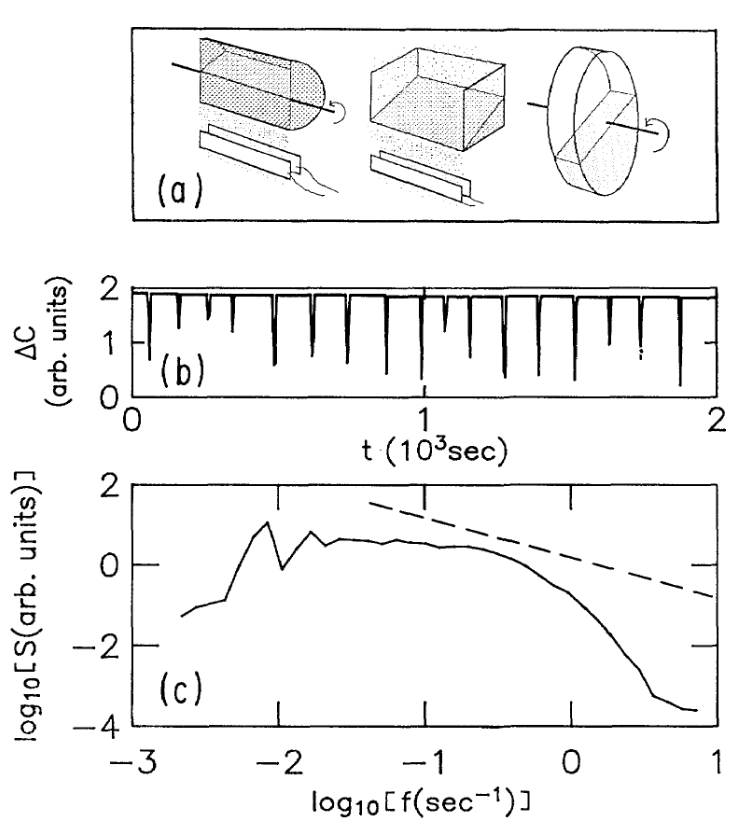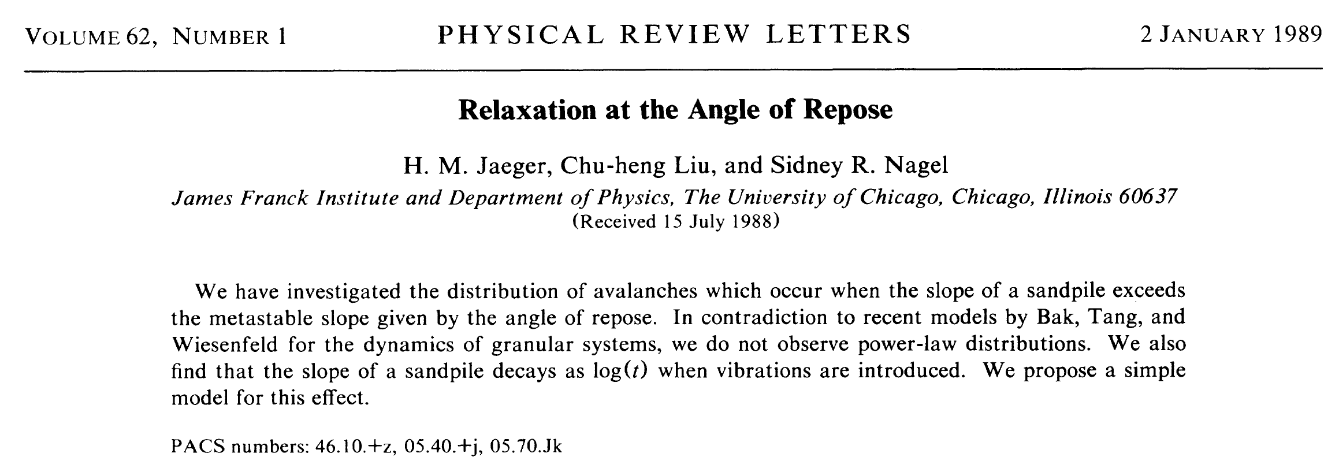We have investigated the distribution of avalanches which occur when the slope of a sandpile exceeds the metastable slope given by the angle of repose. In contradiction to recent models by Bak, Tang, and Wiesenfeld for the dynamics of granular systems, we do not observe power-law distributions. We also find that the slope of a sandpile decays as $\log{(t)}$ when vibrations are introduced. We propose a simple model for this effect.
我们研究了当沙堆的坡度超过由休止角给出的稳定坡度时发生的雪崩的分布情况。与 Bak、Tang 和 Wiesenfeld 最近提出的颗粒系统动力学模型相矛盾的是,我们没有观察到幂律分布。我们还发现,当引入振动时,沙堆的斜率会以 $\log{(t)}$ 的形式衰减。我们为这种效应提出了一个简单的模型。
Sandpiles have often been used as a metaphor for other phenomena in physics. As children we have played with sand and it is only natural to believe that we can intuit the processes underlying the shape and dynamics of these structures. Thus de Gennes has compared the motion of vortices in superconductors to avalanches in sandpiles, and Souletie has argued that spin-glasses and sandpiles behave in a similar manner. Dry, noncohesive, granular material like sand can flow, resembling a liquid, but also, like a solid, can sustain under the influence of gravity a finite “angle of repose,” $\theta_{r}$. This is the angle between the horizontal and the free surface of the sandpile after a land slide has restored the pile to a metastable equilibrium slope.
沙堆经常被用来比喻物理学中的其他现象。孩提时代,我们就玩过沙子,因此自然而然地认为我们可以直观地了解这些结构的形状和动力学过程。因此,de Gennes 将超导体中的涡旋运动比作沙堆中的雪崩,而 Souletie 则认为自旋玻璃和沙堆的行为方式类似。像沙子这样干燥、无粘性的颗粒状材料可以像液体一样流动,也可以像固体一样在重力作用下保持有限的 “休止角”,即 $\theta_{r}$。这是在滑坡使得沙堆恢复到稳定平衡坡度后,水平面与沙堆自由表面之间的夹角。
As early as 1773 the connection between $\theta_{r}$ and the static internal friction of a given material was developed by Coulomb. The analogies mentioned above were made because it is tempting to think of a phase transition occurring at $\theta_{r}$: For slopes such that $\theta < \theta_{r}$ no flow of sand can occur and the pile appears to be a solid whereas for $\theta > \theta_{r}$ the top layers of sand flow freely downhill. Most recently Bak, Tang, and Wiesenfeld introduced the idea of “self-organized criticality” in terms of a model of how they expected a sandpile to behave.
早在1773年,Coulomb 就提出了 $\theta_{r}$ 与特定材料的静态内摩擦力之间的联系。上面提到的类比是因为人们很容易想到相变发生在 $\theta_{r}$:当坡度为 $\theta < \theta_{r}$ 时,沙子不会流动,沙堆看起来是一个固体;而当坡度为 $\theta > \theta_{r}$ 时,顶层的沙子会自由地向下流动。最近,Bak、Tang 和 Wiesenfeld 提出了 “自组织临界性 “的概念,他们希望沙堆能有这样的表现。
Clearly their ideas may have much wider applicability than to just sandpiles, but it is this analogy which makes their model so intuitively appealing. Their idea rests on the assumption that $\theta_{r}$ is a critical angle. If the angle $\theta$ of the free surface is increased continuously (e.g., by adding more material to the top or by tilting the base of the pile), the pile will organize itself such that its average slope will be the angle of repose $\theta_{r}$ by unloading excess material through avalanches.
显然,他们的想法可能不仅仅适用于沙堆,还有更广泛的适用性,但正是这种类比使他们的模型具有如此直观的吸引力。他们的想法基于这样一个假设:$\theta_{r}$ 是一个临界角。如果自由表面的角度 $\theta$ 不断增大(例如,通过向顶部添加更多材料或倾斜堆底),通过雪崩卸载多余的材料,堆体将自组织,使其平均坡度成为倾角 $\theta_{r}$。
Bak, Tang, and Wiesenfeld predict a self-organized state at $\theta_{r}$ characterized by long-range spatial and temporal correlations and giving rise to a typical “$1/f$” power spectrum of the fluctuations around the steady-state particle flow.
They further suggest an analogy between the nonequilibrium behavior of sandpiles and traditional critical phenomena and find a power-law dependence for the relaxation from a supercritical state $\theta > \theta_{r}$ back to the critical state.
Bak、Tang 和 Wiesenfeld 预测了 $\theta_{r}$ 处的自组织状态,其特点是长程空间和时间相关性,并产生了围绕稳态颗粒流波动的典型 “$1/f$” 功率谱。
他们进一步提出了沙堆的非平衡态行为与传统临界现象之间的类比,并发现了从 超临界状态 $\theta > \theta_{r}$ 弛豫到临界状态的幂律依赖关系。
Motivated by the above conjectures we have investigated the nature of particle flow along the free surface in a model system for granular materials: “sandpiles” consisting of spherical glass beads or rough aluminum-oxide particles. We report here on the power spectrum for fluctuations as well as on relaxation properties.
受上述猜想的启发,我们研究了颗粒材料模型系统中颗粒沿自由表面流动的性质:“沙堆” 由球形玻璃珠或粗糙的氧化铝颗粒组成。我们在此报告了波动的功率谱以及弛豫特性。
We have performed the experiment in two basic configurations [see Fig. 1(a)]. The average slope of the free surface was varied either by turning a semicircular drum (i.e., tilting the free surface of the pile) partially filled with granular material, or by randomly adding particles to the top surface of a pile contained in a box with one open side. The semicircular drum of width $8\text{ cm}$ and radius $5\text{ cm}$ had an angular velocity $\Omega = 1.3^{\circ}/\text{min}$.
我们以两种基本构型进行了实验[见图 1(a)]。自由表面的平均坡度可以通过转动部分装满颗粒材料的半圆形圆桶(即倾斜沙堆的自由表面)来改变,也可以通过在装有一侧开口的盒子的沙堆顶表面随机添加颗粒来改变。宽度为 $8\text{ cm}$、半径为 $5\text{ cm}$ 的半圆形圆桶的角速度为 $\Omega = 1.3^{\circ}/\text{min}$。

(a) Schematic diagram of the three experimental configurations (left to right): A rotating semicircular drum, an open box with sand added from the top, and a closed cylindrical drum. In the first two the sand falls through a pair of capacitor plates, (b) The time trace of a typical sequence of avalanches in a rotating drum ( $\Omega = 1.3^{\circ}/\text{min}$ ) with spherical glass beads. $\Delta C$ is the change in capacitance due to the flow of the beads through the capacitor, (c) The power spectrum, $S(f)$, for the above time trace. Dashed line shows a $1/f$ power spectrum for comparison.
(a) 三种实验结构示意图(从左到右):一个旋转的半圆形圆桶、一个从顶部加入沙子的开放式盒子和一个封闭的圆柱形圆桶。在前两种情况下,沙子通过一对电容器板落下; (b) 装有球形玻璃珠的旋转滚筒($\Omega = 1.3^{\circ}/\text{min}$ )中典型雪崩序列的时间轨迹。$\Delta C$ 是由于珠子流经电容器而引起的电容变化、 (c) 上述时域追踪的功率谱 $S(f)$。虚线表示 $1/f$ 的功率谱,以供比较。
Several box geometries were used having a width of approximately $5\text{ cm}$ and aspect ratios (width/length) ranging from $\frac{1}{3}$ to $3$. In the drum we used spherical glass beads of average diameter $0.54 \pm 0.08\text{ mm}$. For the open box we used smaller beads, $0.07\pm 0.01$-$\text{mm}$ average diameter, to keep the momentum transfer as low as possible when the particles hit the surface of the pile.
我们使用了几种宽度约为 $5\text{ cm}$、长宽比(宽度/长度)从 $\frac{1}{3}$ 到 $3$ 的盒子。在滚筒中,我们使用了平均直径为 $0.54 \pm 0.08\text{ mm}$ 的球形玻璃珠。在开口箱中,我们使用了更小的玻璃珠,平均直径为 $0.07\pm 0.01$-$\text{mm}$,以便在颗粒撞击堆表面时保持尽可能低的动量传递。
The results in both configurations were insensitive to the particle size although for the very small particles the experiments were performed in a drybox since special care had to be taken to prevent cohesion due to moisture. We also performed the experiment with rough aluminumoxide particles of diameter $0.5\pm 0.1\text{ mm}$.
这两种构型的结果对颗粒大小都不敏感,不过对于非常小的颗粒,实验是在干燥箱中进行的,因为必须特别注意防止水分造成的内聚。我们还用直径为 $0.5\pm 0.1\text{ mm}$ 的粗糙氧化铝颗粒进行了实验。
The flow of particles over the open edge of the drum or box was detected by a parallel-plate capacitor through which the particles flowed. The corresponding time sequence of capacitance changes, $\Delta C$, was detected by a bridge circuit and fed into a spectrum analyzer. Capacitance changes directly correspond to changes in the flow rate of particles. The resolution was sufficient to detect even the passage of only a few particles at a time.
颗粒流过滚筒或盒子的开口边缘时,会被一个平行板电容器检测到。电容变化的相应时间序列($\Delta C$)由电桥电路检测并输入频谱分析仪。电容变化直接对应于颗粒流速的变化。其分辨率甚至足以检测到每次只有几个颗粒通过。
We show, in Fig. 1 (b), a typical time trace and, in Fig. 1(c), the corresponding power spectrum obtained with the rotating drum using the spherical glass beads. Similar results were obtained with the open box and for the case of rough aluminum-oxide particles.
Each inverted spike in Fig. 1(b) corresponds to a major avalanche, in almost all cases spanning the whole free surface of the system. The avalanches start at an angle $\theta_{m} = \theta_{r} + \delta$ (where $\delta$ is typically a few degrees) and return the pile to its metastable state at $\theta_{r}$. The distributions for the $\Delta t$ interval between avalanches and their width $\tau$ are sharply peaked near their average values as shown in Fig. 2.
我们在图 1(b)中显示了典型的时间轨迹,在图 1(c)中显示了使用球形玻璃珠的旋转滚筒获得的相应功率谱。使用开放盒和粗糙氧化铝颗粒时也得到了类似的结果。
图 1(b) 中的每个倒置尖峰都对应一个大雪崩,在几乎所有情况下都涵盖了系统的整个自由表面。雪崩开始的角度为 $\theta_{m} = \theta_{r} + \delta$(其中 $\delta$ 通常为几度),并在 $\theta_{r}$ 处将沙堆回复到其稳定状态。如图 2 所示,雪崩之间的 $\Delta t$ 间隔及其宽度 $\tau$ 的分布在其平均值附近出现尖峰。
The nearly uniform spacing of avalanches, $\langle\Delta t\rangle = \langle\Delta\theta\rangle/\Omega$, corresponds to the broadened peak at $f=l/(\Delta t)$ in the power spectrum. The roll off at high frequencies above $f = 1/\langle\Delta t\rangle$ is due to the finite width $\tau$ of the individual avalanches. Its average power-law decay, close to $f^{-3}$ , is explained by variations between rectangular and triangular pulse shapes of individual events.
雪崩的间距几乎是均匀的,$\langle\Delta t\rangle = \langle\Delta\theta\rangle/\Omega$,这与功率谱中 $f=l/(\Delta t)$ 处的增宽峰值相对应。高于 $f=1/\langle\Delta t\rangle$ 的高频滚降是由于单个雪崩的有限宽度 $\tau$ 造成的。其平均幂律衰减接近于 $f^{-3}$,是由单个事件的矩形和三角形脉冲形状之间的变化造成的。
In the relevant frequency range, between $1/\langle\Delta t\rangle$ and $1/\langle\tau\rangle$, the spectra appear frequency independent. This finding is in conflict with Bak, Tang, and Wiesenfeld who predicted power-law behavior, $f^{-\theta}$, with $\theta\approx 1$ . Such behavior would have followed from a power-law distribution of widths $\tau$ implying events over a wide range of time scales. Instead we find that the power spectrum is indicative of a linear superposition of global, system-spanning avalanches with a narrowly peaked distribution of time scales.
在相关频率范围内,即 $1/\langle\Delta t\rangle$ 和 $1/\langle\tau\rangle$ 之间,谱似乎与频率无关。这一发现与 Bak、Tang 和 Wiesenfeld 预测的幂律行为($f^{-\theta}$, $\theta\approx 1$)相冲突。这种行为本应来自于宽度 $\tau$ 的幂律分布,这意味着事件发生在很宽的时间尺度范围内。相反,我们发现功率谱显示的是全局、整个系统雪崩的线性叠加,其时间尺度分布呈窄峰值。
This situation is a direct consequence of the existence of a nonzero value of $\delta$. The phenomenon was first explained as dilatation by Reynolds in 1885. For particles to slide on the surface, $\theta_{r}$ (which corresponds to the metastable configuration after an avalanche) must be exceeded by an additional amount $\delta$ to allow for clearance with the profile of the underlying layer.
As long as effects from the retaining walls of the container can be neglected we find $\langle\theta_{r}\rangle = 26^{\circ}$ and $\langle\delta\rangle = 2.6^{\circ}(5^{\circ})$ for glass beads (aluminum-oxide particles), independent of container or grain size.
这种情况是 $\delta$ 非零值存在的直接结果。Reynolds 于 1885 年首次将这种现象解释为膨胀。要想让粒子在表面滑动,$\theta_{r}$(对应于雪崩后的亚稳态构型)必须超出额外的 $\delta$,以便与底层的轮廓保持间隙。
只要可以忽略容器挡墙的影响,我们就会发现对于玻璃珠(氧化铝颗粒)来说,$\langle\theta_{r}\rangle = 26^{\circ}$ 和 $\langle\delta\rangle = 2.6^{\circ}(5^{\circ})$, 与容器或颗粒大小无关.
These values for $\langle\delta\rangle$ agree with calculations by Bagnold who also predicted the periodic occurrence of avalanches in the steady state. We believe that the observation of a wide spread of values for $\Delta t$ by Evesque and Rajchenbach is due to wall effects in a comparatively narrow system.
这些 $\langle\delta\rangle$ 值与 Bagnold 的计算结果一致,他也预测了雪崩在稳定状态下的周期性发生。我们认为,Evesque 和 Rajchenbach 观察到的 $\Delta t$ 值的广泛分布是由于在一个相对狭窄的系统中的墙壁效应造成的。
Since $\theta_{m}$ is inherently unstable, the hysteresis, $\delta$, is easily reduced to zero by the application of mechanical vibrations to the system. By adjusting the intensity of the vibrations one can span the transition from solidlike to liquidlike behavior of the granular material in a very controlled way.
We induced vibrations by a speaker mechanically coupled to the system. This configuration allowed us in a convenient way to address whether $1/f$ fluctuations in the steady-state particle flow for $\Omega = \textit{const}$ could be recovered if $\delta\rightarrow 0$. It also allowed us to investigate, for $\Omega = 0$, the time dependence of $\theta(t)$ as the average angle of the free surface relaxes under the influence of the vibrations.
由于 $\theta_{m}$ 本身并不稳定,因此通过对系统施加机械振动,可以轻松地将滞后 $\delta$ 降为零。通过调整振动的强度,就能以非常可控的方式实现颗粒材料从固态到液态的转变。
我们通过一个与系统机械耦合的扬声器来诱导振动。这种配置使我们能够以一种简便的方式来解决当 $\Omega = \textit{const}$ 时,稳态粒子流中 $1/f$ 的波动是否可以在 $\delta\rightarrow 0$ 时恢复的问题。在 $\Omega = 0$ 的情况下,我们还可以研究 $\theta(t)$ 在振动影响下自由表面平均角度弛豫的时间依赖性。


